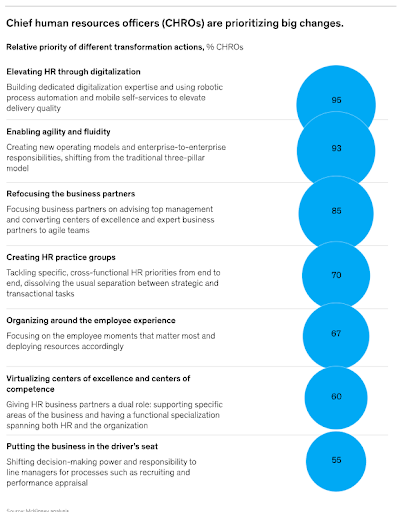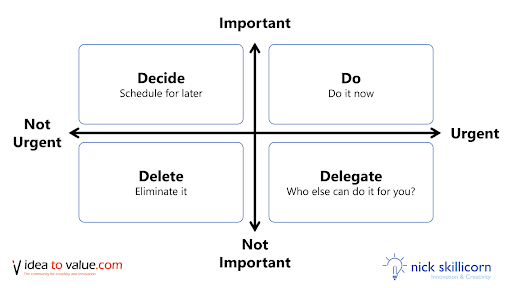The ability to act as a strategic partner to the business is the ultimate indication of an HR team’s success.
HR professionals' ability to act strategically is so important that companies are fundamentally changing how they work to enable them to spend less time on transactional work and more time on strategic work.
Organizations globally are deploying increasingly advanced HR tech like best-in-class HRIS and analytics platforms to drive this transformation and new roles are being designed around embedding strategy into various HR functions. For instance, “strategy” is now embedded into my job title.
In my day job, I’m a Director of Talent Strategy. This means I’m accountable for leading the design, development, and deployment of strategies that will impact the learning, growth, and development of talent within my organization.
But I didn’t get to this point overnight. My journey to becoming a strategic partner took a great deal of time, effort, energy, and networking.
It required taking intentional steps to build trust with leaders across my organization, including:
- Shadowing people in various parts of the business to understand their wants and needs
- Site visits to understand how our leaders interact with our front-line team members
- Actively nourishing relationships with leaders across the enterprise through gaining a deep understanding of both their business and personal career goals and then helping enable them to succeed in both spaces.
My work in this space paid dividends. I was able to elevate my role and be seen as a valued partner to the leader I support.
Here, my goal is to help you rethink how both you and/or your HR function can operate as a more strategic partner to the business areas you support.
Let’s dive in.
What Is An HR Strategic Partner?
Simply put, an HR strategic partner is a human resources professional, or HR department, whose work is structured around enabling the business teams they support to deliver upon their goals.
In practice, this means working hand in hand with the business to help define their goals, identify the actions or activities needed to meet their goals (roadmaps), identify metrics to track your success, and, most importantly, align their talent in such a way to be successful.
For me, this is all about having a different mindset. HR leaders need to stop looking at themselves as human resources colleagues/leaders, but rather as business colleagues/leaders who specialize in HR.
This shift in thinking is empowering. HR colleagues are no longer an extra set of hands to carry out transactional work, but a true business partner helping create value for the business.
How Does Strategic HR Benefit The Business?
HR becoming a strategic partner is a must-have for any organization that wants to remain competitive in today's ever-changing business environment. By prioritizing strategic HR, companies can create a more efficient and effective workforce, which can lead to improved business outcomes.
Strategic HR benefits the business in several ways:
- Aligning talent with business goals. Whether it’s through talent reviews, succession planning, org design, or other workforce planning activities, a critical strategic HR function is to ensure leadership alignment and that HR’s goals are aligned with business goals.
- Create a culture of continuous learning, growth, and development. An increased focus on strategic HR partnerships helps HR teams focus on our most critical priority—our talent. Strategically building and enabling a culture of learning and development not only benefits the career growth of your employees but also your bottom line.
- Attract and retain top talent. HR’s ability to co-create an employer value proposition (EVP) centered around attracting and retaining talent is an important strategic benefit.
- Improve employee engagement and the employee experience. A focused and strategic HR function plays a significant role in partnering with leaders across the organization to create the best possible company culture and employee experience.
- Increased operational efficiency: Strategic HR improves operational efficiency by optimizing workforce planning and management. This includes reducing costs through effective talent management strategies, improving workforce productivity, and leveraging technology to improve processes.
HR Strategic Partner Example
Let’s look at a real-world example of how HR as a strategic partner benefits an organization.
I’m currently involved in a strategic talent initiative with our technology team designed to elevate our talent and propel our organization into the future. This initiative has multiple workstreams, each co-led by a business executive and an HR leader.
The HR leaders were chosen not just for their technical HR expertise (i.e. I help lead our learning, growth, and development work), but also for their deep understanding of our business, our employees, and our customers.
This strategic partnership between HR and the business has led to stronger success than if the work was led by the business or HR alone.
The HR leaders often have a deeper understanding of our colleagues' wants and needs and can therefore act as a voice for our colleagues when we develop strategic roadmaps for each workstream
This empowers us to build solutions that marry both our business needs and the needs of our employees.
How To Become An HR Strategic Partner

I believe that most HR colleagues and organizations see the value of a strategic partnership. That said, knowing that you should do something is a lot different from actually doing it.
Becoming an HR strategic partner won’t happen overnight. It requires an investment of time to build new skills, potentially create new processes, and develop a new level of trust with your business partners.
But, once you’ve gotten there, the benefits you’ll reap will far outweigh the work you put in along your journey.
Let’s dive into how you can become an HR strategic partner.
Understand your business
The most important place to begin your HR strategic partner journey is by having a deep understanding of the business.
Human resources professionals cannot play in this space if they do not have a comparable level of depth and breadth in their understanding of the business as their client groups.
A friend and mentor of mine always coaches his teams by saying “In order to support the business, you need to understand the business better than your business does.”
While a whimsical exaggeration, the spirit rings true. Without a deep understanding of the work your business colleagues do, you’ll never be able to provide them with the strategic guidance and support they need.
A shared appreciation and understanding of their work elevates your role from order taker into that of a strategic partner.
So how do you go about learning about the business?
In my opinion, there are no shortcuts here. This takes time, effort, and intentionality, and is a critical part of your personal growth and development.
Some ways you can build your business knowledge include:
- Build into your individual development plans (IDP). HR leaders and employees should take purposeful looks at how to build IDPs that focus on mechanisms to learn the business (e.g. new projects/stretch assignments that will expose colleagues to parts of the business they haven’t supported).
- Listening to earnings calls. If your organization is publicly traded, earnings calls provide a wealth of information not just to the investor community but to anyone trying to gain a deep understanding of the business, its strategy, and financial performance.
- Build formal relationships. Prioritize the leaders you have access to across the business and take advantage of your time with them. Where appropriate to your role/relationship, schedule regular 1:1s and show an interest in learning about them, their teams, and their work. This is your opportunity to build a trusted relationship, act in a strategic consultative way, and help enable the business strategy.
- Tap into your internal network. Informal learning through your network is one of the best (and psychologically safest) ways to learn. Ask colleagues in your internal network to join you for coffee or lunch and go prepared with questions to learn more about the work they do in their area.
- Surveys/interviews/focus groups/listening sessions with your employees and leaders. If you work in a large organization, tools like surveys or a series of listening sessions can be valuable for learning more about the business and your colleagues.
- Attend strategy meetings. Sitting in on (and eventually contributing to) business strategy sessions is a great way to see strategic planning in action, learn about your business strategy sessions, and gain an active seat at the table to contribute over time.
- Day in the life. Shadow days are a great way to see the business in action. This is a great way to meet the people you support, understand what they do, what their wants and needs are, and ensure that your strategies are designed to meet their needs.
Make time for strategy by removing transactional tasks
A major barrier to becoming a strategic HR partner is time. There are only so many hours in a day and you need to be very intentional in how you spend them.
I like to think about this in two ways:
- HR governance model. What can be changed about our operating model to free up time for HR professionals to be more strategic?
- Self-governance. How can you prioritize your work differently to spend more time on more strategic needs?
HR governance model
It’s important to understand how your human resources processes, systems, and tools are impacting how your HR colleagues are spending their day.
It’s easy to say “Be more strategic”, but the reality is that there are still administrative or transactional responsibilities that HR needs to get done.
Increasingly, organizations are looking at new HR operating models that prioritize the use of technology to augment HR capabilities and redirect HR personnel to better focus on strategic imperatives.
According to McKinsey and Company’s research with CHROs from across the globe, 90% of CHROs predicted significant changes in HR operation models over the next few years:

When deployed correctly, these changes will fundamentally shake up your HR delivery model and ensure your HR team is focusing on what’s going to drive the most value to your organization.
Self-governance
While you may not always be able to influence or change the overall way human resources functions within your organization, you should have some level of control over how you spend your time.
While there will always be urgent work that takes away from important things you need to accomplish, it’s important to not let the “urgent” continuously get in your way of accomplishing what’s truly important.
A popular method for helping you to avoid the ‘urgency trap’ is the Eisenhower Method.
This method was popularized based on a 1954 speech during which Dwight D Eisenhower articulated that “I have two kinds of problems: the urgent and the important. The urgent are not important, and the important are never urgent.”
Your strategic HR work becomes your urgent and important work and ultimately bubbles up to the top. This lens helps you prioritize what you should do now, save for later, or delegate or eliminate if possible.
Collect and analyze data
HR professionals need to be comfortable working with data and using it to drive insights and decision-making.
Being a shepherd of this data to your business teams is critical—you need to be able to collect the relevant data, analyze it, and take a data-driven approach to inform both HR strategy and business strategies and initiatives.
The data you collect should be mapped back to your strategic imperatives and help track your progress against the goals. This can span across all sections of HR and the business (think talent acquisition, learning and development, employee engagement, DEI, retention/turnover).
A helpful way to think about data so that you don’t try to boil the ocean is to look at key performance indicators (KPIs).
KPIs are a critical way in which strategic business partners can help the business drive decision-making, incrementally improve performance, and ensure value realization.
If you’re looking for inspiration on which KPIs might be helpful for you to measure and enable your organization’s strategy, check out my article on developing HR KPIs.
Build strategic skills and capabilities
Acting as a strategic partner is going to be a completely new foray for many HR professionals.
Therefore, if you or your organization is trying to transform the way you work to be more strategic, you’ll need to develop an entirely new set of capabilities to be successful in this space (see below).
As with all things development-oriented, I recommend taking the 70-20-10 approach to developing strategic HR capabilities.
This means spending 70% of our time on experiential learning, 20% percent on social learning, and 10% on formal training (this is important).
You won’t become a truly HR strategic partner through reading books.
Having a strong mentor or coach to help you build strategic capabilities, combined with rolling up your sleeves and engaging in hands-on experiences that stretch your strategic capabilities, is essential in rounding out your development in this space.
Your organization may have an HR competency model in place that you can base your development on. If not, I’d encourage you to think through which competencies and skills will be essential to your success in this space at your organization.
I recommend the following competencies as a starting place:
- Business acumen
- HR acumen
- Strategic thinking
- Relationship building
- Influencing
- Data analysis
- Change management
- Collaboration
- Consulting
- Resource management
- Market analysis
- Goal setting/roadmapping
- Forecasting/planning
- Prioritization
Change how the business thinks about HR
You’ll never succeed in becoming an HR strategic partner unless you change how the business thinks about HR and/or your relationship with them.
This is essentially a change management effort. You’ll need to help leaders understand how you are changing the ways that you support them and drive the adoption of your expanded relationship with them.
I think it’s incredibly important to take your business leadership team on this journey. This is true if you’re doing something transformational for your HR team to move your entire organization into a more strategic direction (i.e., updating your HR operating model), or if you’re trying to change the relationship you have with the business leaders you work with more organically.
Let your stakeholders know what you’re trying to do, ask them to help define what it is they need from you, and make sure you are realigning your HR approach around their wants and needs.
Lastly, don’t be afraid to take an agile approach to changing your relationship with the business. This means starting small, collecting feedback, iterating, and adapting to ensure you continue to meet the needs of the business.
From Partner To Leader
Your transformation into becoming a strategic HR business partner (HRBP) won’t happen overnight. Like anything else, I would recommend starting small and expanding over time.
I truly believe that having a deep understanding of the business is the only place to start on your HR strategic partner journey.
Being an HR strategic partner is all about enabling your business to achieve its goals. You’ll never achieve this without a deep understanding of your organization’s business operations, financial trends, and industry dynamics.
Once you’ve mastered this, you’ll have the baseline trust and rapport with your business leaders to be viewed as a partner (and not just another set of hands to delegate to).
This is the foundation upon which you nourish your strategic relationship over time and transform how you support your business.
But why stop there?
Eventually, HR should strive to become a business leader that colleagues look to for leadership and guidance with a voice at the highest levels of the organization. HR’s time has come.
Join the People Managing People Community
For more advice on becoming a strategic partner, join our supportive community of HR and business leaders sharing knowledge and best practices to help you grow in your career and make greater impact in your organization.



